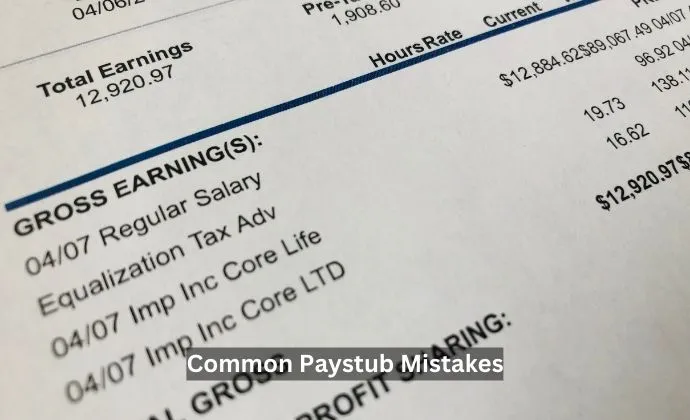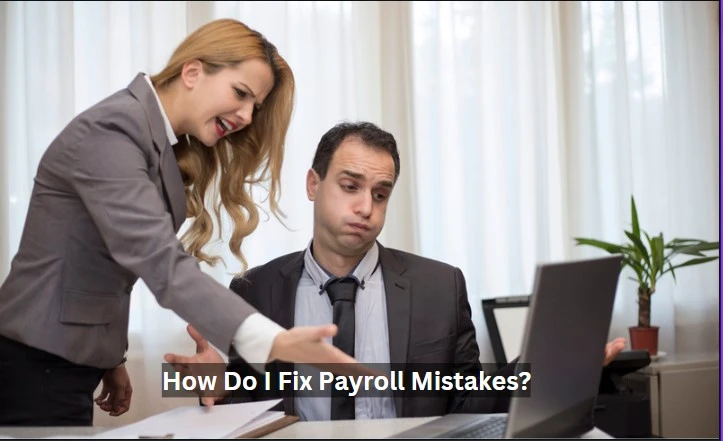Common Mistakes While Making Paystubs and How to Avoid Them
- Home
- Blog
- Paystub Generator
- Common Mistakes While Making Paystubs and How to Avoid Them
Making an employee pay stub is an essential part of payroll processing. However, mistakes can happen, and they can have a significant impact on both employees and the company.
In this blog, we'll discuss some of the common mistakes you can make while making paystubs and how to avoid them.
Common Paystub Mistakes

-
Incorrect Information
This is one of the most common mistakes you can make while making pay stubs. It can include a wrong name, address, or social security number.
-
Calculation Errors
This is a result of common accounting mistakes in business, especially when calculating taxes, deductions, and overtime pay. Hence, it can lead to discrepancies in an employee's pay.
-
Incorrect Tax Withholding
Tax withholding errors can lead to under or overpayment of taxes. Hence, it can result in penalties and interest charges.
-
Missing Information
The information comprises an employee's pay rate, hours worked, or overtime hours. With missing details, you will have incorrect pay calculations.
-
Failure to Include Required Information
If you do not include the right details, you'll have legal issues and potential compliance penalties. Some essential information entails state and federal taxes, Social Security, and Medicare deductions.
How to Avoid Paystub-Making Errors

You can avoid making pay stub errors by following these tips:
-
Double-check All Information
Always double-check all the information before creating a pay stub. This will ensure everything you include is correct, and you won’t end up with a fake pay stub.
-
Use Payroll Software/ Paystub Generator
Consider using a pay stub generator to automate the pay stub creation. This will help you minimize errors and avoid fake pay stubs.
-
Update Tax Information Regularly
Stay up-to-date with tax laws and regulations. Also, ensure you update your tax information regularly to avoid getting into legal trouble.
-
Ensure You Include the Required Information
These include gross pay, deductions, and net pay, among other essentials.
-
Check for Consistency
Maintain consistency throughout your calculations to ensure correct pay for your employees.
Impact of Payroll Errors on Employees
As an employee, common payroll mistakes can have a significant impact on your life. Here are the consequences of paystub errors:
- Financial Loss: One of the most obvious impacts of fake payroll stubs is financial loss. If you are not paid the correct amount, you may struggle to make ends meet. Or, you may have to delay paying bills or other expenses. This can be difficult if you have a tight budget or rely on your paycheck to cover essential costs like rent or groceries.
- Delayed Payments: If your employer makes a mistake with your paycheck, it may take several days or even weeks to correct the issue. This can cause stress and anxiety, especially if you want to pay for something important.
- Compliance Issues: Another impact of payroll errors is compliance issues. If your employer fails to withhold the correct amount of taxes from your paycheck, you may end up owing more money to the government at tax time. Moreover, if your employer does not comply with labor laws, you may be at risk of being penalized or losing the benefits or protections you are entitled to.
Impact of Payroll Errors on the Company
Below are some of the major impacts of payroll errors on a company:
- Damage to Reputation: Payroll errors can damage a company's reputation, especially if the errors result in late or incorrect payments to employees. This can cause employees to lose trust in the company. Moreover, it damages the firm's relationship with its suppliers and vendors. In turn, this can lead to a loss of business and revenue for the company.
- Legal Penalties: These can occur if the company violates employment laws or if the errors result in underpayment or non-payment of wages or taxes. Such penalties can be costly and time-consuming.
- Decreased Employee Morale: Payroll errors can cause significant stress and anxiety for employees if they result in delayed or incorrect payments. This can lead to decreased employee morale and job satisfaction. Hence, it results in decreased productivity. Additionally, if employees perceive that the company is not taking their pay seriously, they may become less committed to their main goals and objectives.
How to Make Pay Stubs for Employees Without Mistakes
To make pay stubs for employees without mistakes, follow these steps:
- Gather All Information: Look for all necessary information, including employee name, address, Social Security number, pay rate, hours worked, and deductions.
- Use Payroll Software: This software will automate the pay stub creation process and hence minimize errors.
- Verify Information: Double-check all the information before creating a pay stub to ensure that it's correct.
- Check for Consistency: Examine consistency in all calculations to ensure accurate pay figures. Hence, you'll avoid payroll error underpayment.
- Include Required Information: Ensure you include all the required information in the paystub, including gross pay, deductions, net pay, etc.
What are Some of the Possible Causes of Payroll Run Errors?
Some of the causes of payroll run errors include:
- Human Error: This includes incorrect data entry.
- Lack of Training: Payroll experts who lack proper training or experience may make mistakes while processing payroll.
- Outdated Payroll Systems: Outdated systems or manual processes can increase the possibility of making errors.
- Inaccurate Information: Wrong employee information or changes recorded incorrectly can cause payroll errors.
- Tax Law Changes: Changes in tax laws or regulations may result in errors if payroll specialists are not aware of them.
What are the Most Common Mistakes That a Payroll Specialist Can Make?
Here are some of the most common mistakes.
- Incorrect Data Entry: This comprises typing in incorrect numbers or codes.
- Incorrect Calculation: For example, failing to include overtime or miscalculating deductions.
- Not Updating Employee Information: Not updating employee information, like the changes in pay rate or status
- Inadequate Record Keeping: Poor record-keeping can lead to missing information or inaccurate data.
- Not Staying Up-to-date with Tax Laws: Not being up-to-date with tax laws and regulations can cause compliance issues and potential legal penalties.
What Type of Information Should You See When You Look at Your Paystub?
A paystub will contain the following information:
- Gross pay: This is the total amount you earned before any deductions. It includes your salary, hourly wages, and any overtime pay.
- Taxes withheld: This section shows the amount of money withheld from your paycheck for federal, state, and local taxes. This includes income tax, Social Security tax, Fica taxes, and Medicare tax.
- Net pay: This is the amount you will receive after all deductions. It is deposited into your bank account or provided to you in the form of a paper check.
- Deductions: This shows the various amounts deducted from your gross pay. This includes things like health insurance premiums, retirement contributions, a car loan, a mortgage loan, and any other voluntary deductions you may have chosen.
- Benefits: This part shows any benefits you may have received, such as health insurance or retirement plan contributions made by your employer on your behalf.
- YTD (Year-to-date) amounts: This section shows the year-to-date total for each category of pay. For instance, gross pay, taxes withheld, and deductions. This allows you to see how much you have earned and what has been withheld from your pay over the year.
- Pay period dates: These show the dates of the pay period for which the paystub is being issued. It shows the start and end dates of the pay period and the date of the paycheck.
How Do I Fix Payroll Mistakes?

Learn how to avoid payroll errors by following these steps:
- Identify the specific payroll mistake and its cause.
- Notify the employee of the mistake.
- Correct the mistake in the payroll system.
- Follow up with the employee to ensure they receive the correct pay
How Can Payroll Accuracy be Improved?
You can improve accuracy, by implementing the best payroll tips as follows;
- Use payroll software to automate the payroll process and minimize errors.
- Provide payroll specialists with proper training to ensure they have the necessary skills to process payroll accurately.
- Ensure employee records are accurate and up-to-date, including pay rates, tax information, and benefits.
- Regularly review and reconcile payroll reports to identify and correct any errors.
- Stay up-to-date with tax laws and regulations to ensure compliance and avoid penalties.
Why Payroll Errors Should be Avoided?
Payroll errors have significant outcomes for both employees and the company. They include financial loss, compliance issues, legal penalties, and damage to the company's reputation. Moreover, errors can lead to reduced employee morale, productivity, and retention.
By avoiding payroll errors, companies ensure they pay employees accurately and on time. Moreover, the company remains in compliance with tax laws and regulations.
Final Thoughts on How to Avoid Pay Stub Mistakes
Creating an accurate and real paystub is crucial for both employers and employees. Common mistakes like miscalculations, incorrect information, and missing details can have financial and legal consequences.
By following best practices and utilizing reliable paystub generators, you can avoid these errors. Also, it ensures employees receive accurate paystubs every time. Remember, taking time to create precise paystubs will benefit your employees and also protect your business from potential legal disputes.
Kristen Larson is a payroll specialist with over 10 years of experience in the field. She received her Bachelor's degree in Business Administration from the University of Minnesota. Kristen has dedicated her career to helping organizations effectively manage their payroll processes with Real Check Stubs.

